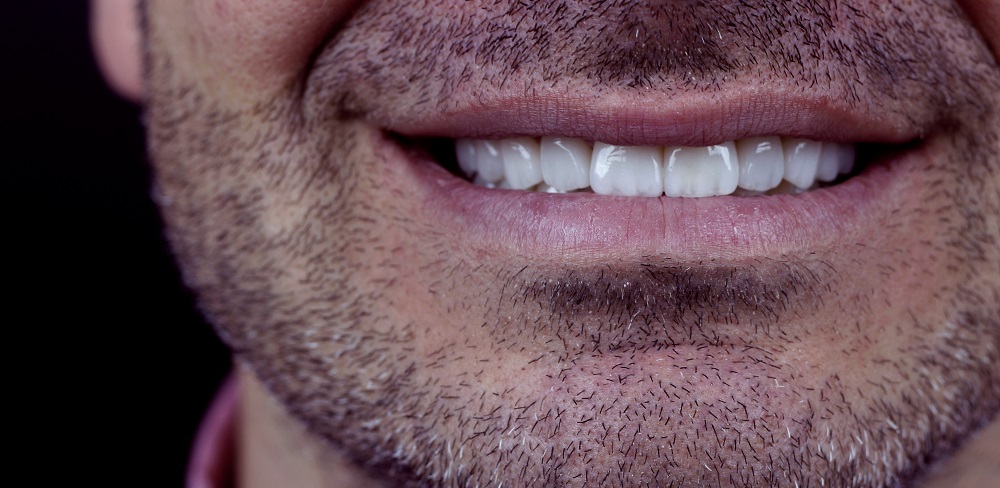This is Part 2 of this series; to see Part 1 click here.
Factors to Consider in Smile Design
There are many critical factors to consider in smile design and creating a perfect smile requires that the clinician understands and applies these in the planning stages of their patient’s new smile. These include lips, smile line, midline, tooth position, frontal and sagittal planes, as well as understanding and the application of critical numbers.
Lips
The lips create the boundary of the smile and need to be considered in smile design. Lip mobility, which is simply the movement of the lips at rest to the final full smile, is directly related to the upper lip length. The average lip length is 23 mm in males, and 20 mm in females, and the average lip mobility is approximately 7-8 mm, with females lifting slightly more than males, and showing more tooth during smiling as a result. Since a significant portion of people has asymmetry of lip movement when smiling, this can result in more or less tooth or gums showing on one side versus the other, creating an overall disharmony in the smile.
The Smile Line
The incisal edge position must be evaluated as it is viewed as related to the interpupillary line as well as the lower lip curvature. In most smiles that are considered beautiful, the incisal edge follows the lower lip/wet-dry line, known as the smile line. Following the smile line is another consideration known as the “buccal corridor”. The buccal corridor is the space that is present between the lateral aspects of the posterior teeth and the corner of the mouth. When there is “dark” space in the buccal corridor, this is considered “negative space” and viewed as unaesthetic.
Midline and Tooth Position
The midline between the upper central incisors is a key component in smile design and can pose challenges if not positioned correctly. It is important to evaluate the relationship between the dental midline (the one between the central incisors) and the facial midline which, if not aligned, may result in a less than ideal outcome. Skeletal asymmetry can create a shift or angulation to the dental midline, making it challenging or impossible to correct, and the patient needs to be aware of this prior to beginning treatment in case this is one of their expectations in the final results.
In addition, the angulation of the midline can destroy the overall look of the smile, and the clinician needs to pay special attention to how the midline appears when a patient smiles. Even the slightest angulation can spoil the final outcome and may require a remake to correct.
Overall tooth position is another factor that can lead to less than ideal results, especially if the tooth and root position or angulation would lead to undesirable restorations. Tipping, position, arch form, occlusion, and the possibility to correct those needs to be understood by the clinician and communicated clearly to the patient prior to beginning treatment. If any of these factors would require either aggressive tooth reduction or thick restorations, both of which compromise the long-term health of the patient’s teeth or gums, this needs to be addressed and managed early in the discussion with the patient in order to manage their expectations.
Frontal and Sagittal Planes
Viewing the smile and tooth position from various planes is another important component to achieve a positive outcome. The sagittal view allows for proper analysis of the current tooth position and determines the extent of change we are able to deliver without infringing on the closed-lip position or violating aesthetic guidelines. If If the front teeth are proclined or retroclined, this can have a direct impact on the amount of reduction needed, or the final thickness of the restoration, and often results in less than ideal restorations. Viewing the smile in the sagittal plane allows the clinician to decide whether or not the ideal smile position can be achieved, and if not, what the limitations and considerations are, prior to beginning treatment.
The frontal view allows for the assessment of current tooth inclination and position of the long axis of the central incisors. In addition, it allows for a detailed evaluation and treatment planning with regard to the Golden Proportion, which is a mathematical analysis tool for assessing the widths and the dominance of the maxillary anterior teeth. The simplest way to view this is to take the lateral incisor as a factor of 1, then the central incisor would be 1.6, and the visible part of the canine in the frontal view would be 0.6. This is applied bilaterally in order to maintain symmetry and result in a balanced smile.
See Part 3 to continue.

